Outdoor
Skill - Lashing
<> Controlling Loose Ends
<> Square Lashing
<> Diagonal Lashing
<> Round, Shear, and Tripod Lashing
<> Continuous Lashing
A separate Outdoor Skills page covers Compass, Emergency Shelter, Estimating, Fire, Knife, Knot, and Trail skills.
These skills, along with cooking and first aid, will come in handy during Camporee events, and at many other times throughout your life.
Lashing
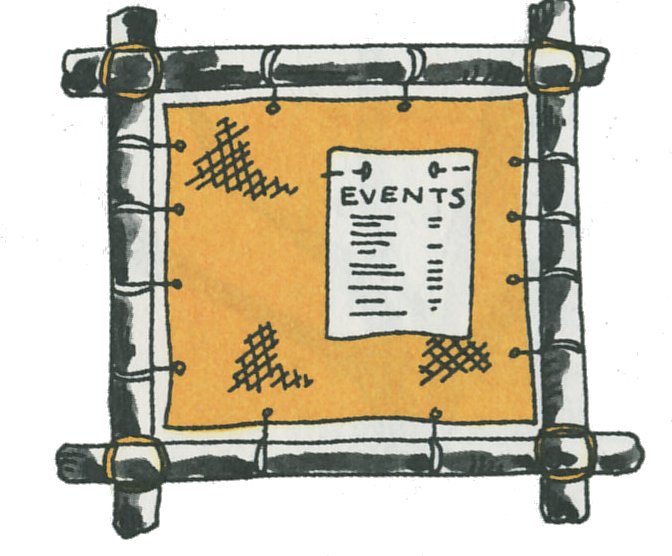 Used by Native Americans and Pioneers, lashing is the term for
fastening two or more sticks or poles together using binder twine or
rope rather than nails.
Used by Native Americans and Pioneers, lashing is the term for
fastening two or more sticks or poles together using binder twine or
rope rather than nails. 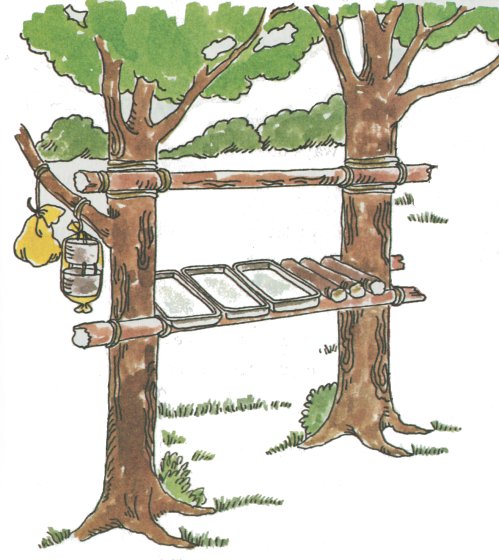 Lashing is a fun and easy way to construct
shelving, racks, flagpoles, hooks, and many useful objects in your
campsite without harming trees. It is more suited to established
campsites, and is often prohibited in the backcountry. It is always a
good idea to ask before building a structure. Use only downed wood and
leave no trace behind when you break camp. In your campsite, you would
use downed wood to construct a structure, but for practicing your
skills at home you can use broomsticks, dowels, bamboo poles, PVC pipe,
or when available, pruned tree limbs. You will also need a spool of
binder twine
Lashing is a fun and easy way to construct
shelving, racks, flagpoles, hooks, and many useful objects in your
campsite without harming trees. It is more suited to established
campsites, and is often prohibited in the backcountry. It is always a
good idea to ask before building a structure. Use only downed wood and
leave no trace behind when you break camp. In your campsite, you would
use downed wood to construct a structure, but for practicing your
skills at home you can use broomsticks, dowels, bamboo poles, PVC pipe,
or when available, pruned tree limbs. You will also need a spool of
binder twine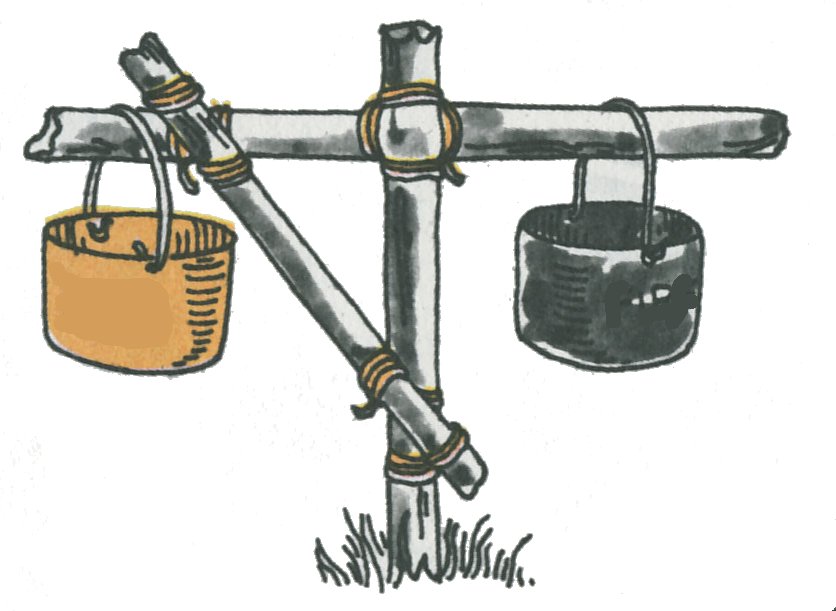 (or string, cord, rope, etc.) and your
pocketknife to cut it. For your campsite, useful
items might include a pruning saw (to cut wood to length) and a hammer
or large rock for pounding sticks into the ground.
Almost all lashing begins with a clove hitch and ends with a square
knot, and should be neat and attractive with the twine lying side by
side, not overlapping. Knowledge of basic lashing techniques will
enable you to build many types of structures.
(or string, cord, rope, etc.) and your
pocketknife to cut it. For your campsite, useful
items might include a pruning saw (to cut wood to length) and a hammer
or large rock for pounding sticks into the ground.
Almost all lashing begins with a clove hitch and ends with a square
knot, and should be neat and attractive with the twine lying side by
side, not overlapping. Knowledge of basic lashing techniques will
enable you to build many types of structures. Remember, all lashing projects, while fun to make and difficult to part with, must be completely taken down and wood scattered when leaving your campsite. Remember to pick up all twine and dispose of correctly.
A useful site for project ideas: www.pioneeringprojects.org.
Look under camp tools/gadgets.
Loose
Ends
Your lashing projects will be much neater, quicker, and easier if you start with your twine in a tidy ball or skein. An easy way to make a skein that will fit your hands and unwind without tangles is to wind your twine across the palm of your hand, around your outstretched thumb and little finger.
Click on control to
play demonstration.
Square
Lashing
Square Lashing can be used to bind long sticks at right angles to trees or poles to form drying racks and for many other uses.
Japanese Mark II Square Lashing is a type of Square Lashing.
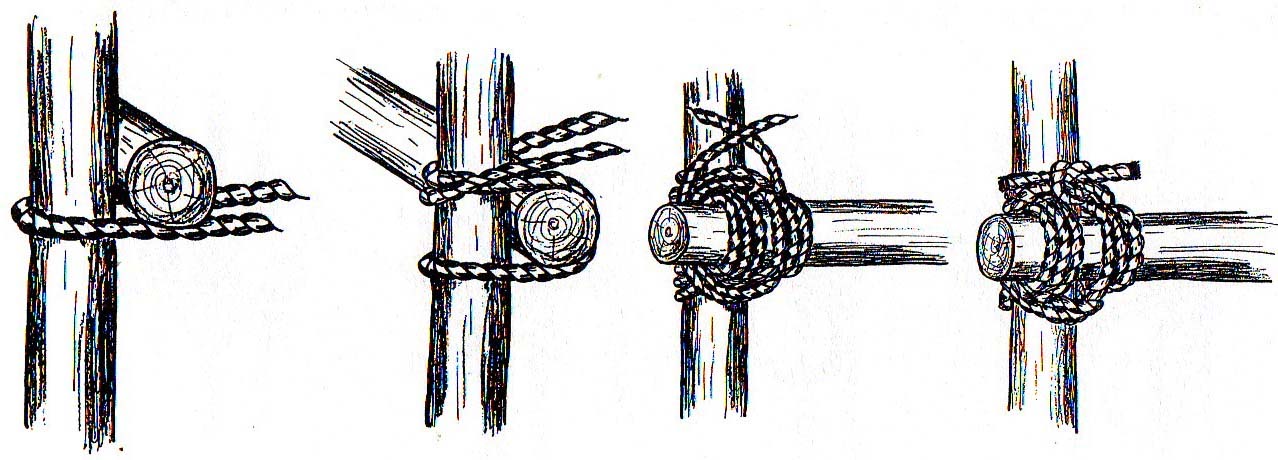
Watch the video to learn about Japanese Mark II Square Lashing
Click on control to
play demonstration.
Traditional Square Lashing

- You begin with a clove hitch on one upright stick (or tree) leaving enough of a tail to tie a square knot when this portion of lashing is complete.
- Cross the other stick at right angles over the first stick (tree).
- Cross the twine over the cross stick and behind the upright stick, then back over the cross stick and under the upper part of the upright stick.
- Continue this 4 times, keeping the twine neat, even, and tight.
- When you’ve finished all sides with four rounds, now you ‘frap’ three times between the sticks
- and finish with a square knot, using the end piece from your original clove hitch.
Click on control to
play demonstration.
Frapping – this tightens the lashing. Wind the twine between the two sticks three times, pulling tightly as you go.
Diagonal
Lashing
Diagonal Lashing may be used to create a freestanding structure.

- Begin by crossing two sticks into an ‘X’.
- Make a clove hitch around both sticks where they cross, again leaving a tail to finish with a square knot.
- Wind the twine tightly four times through one half of the ‘X’.
- Now do the same through the other half of the ‘X’.
- Frap three times between the sticks
- and tie a square knot with the clove hitch tail.
Click on control to
play
demonstration.
Round,
Shear, Tripod
Lashing
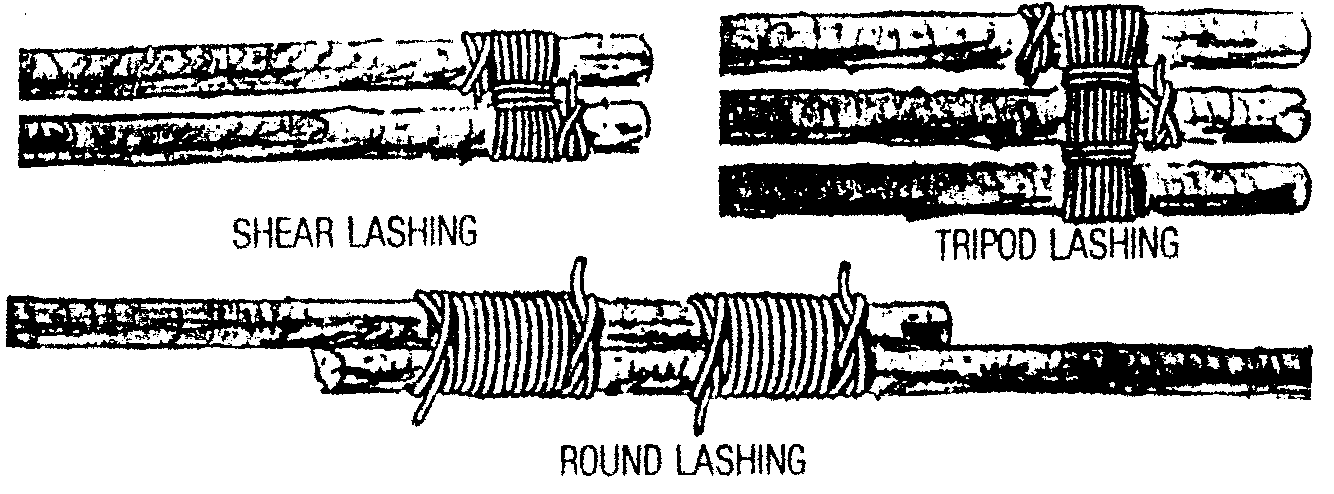
Round Lashing is used when you need to make a pole longer.

- Place two poles so the ends overlap (remember, you are trying to make a longer pole).
- Place a clove hitch around both poles at one end where they overlap.
- Begin winding the twine around both poles until you reach the other end where they overlap.
- If you’ve done this tightly enough, you will not be able to frap this type of lashing.
- Finish the wrapping with a clove hitch.
Shear Lashing adds frapping between the poles. With tight frapping, it can join two poles like round lashing. Looser frapping is a great way to create an A-frame with two poles. It is lashed very much like round lashing above, but not as tightly.

Lay two poles side by side and clove hitch around one pole. Make four or more wraps around both poles, somewhat loosely. Frap three times between the poles, tie a square knot with the original clove hitch end, and raise as an A-frame.
Click on control to
play demonstration.
Tripod Lashing is lashed as for shear lashing, but using three poles. This is useful in creating a tripod for a washbasin, lantern stand, a teepee shelter, or even for growing beans in your garden.
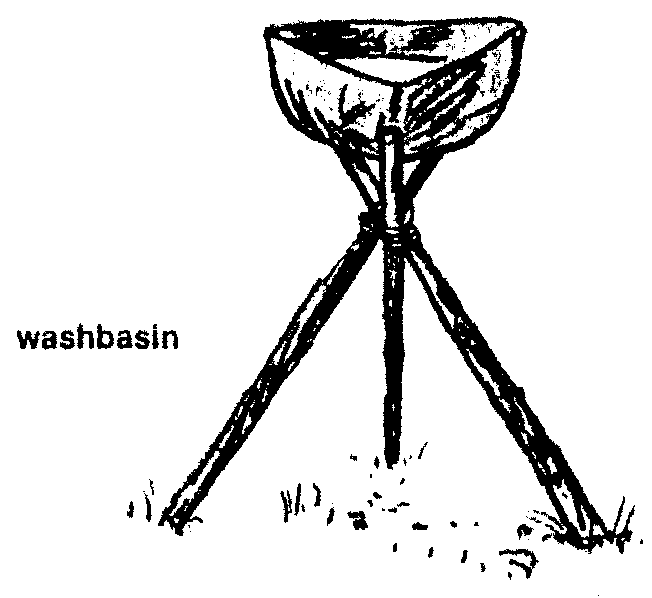 Place three poles next to each other,
overlapping by 4-5- inches, with
the middle one pointing the opposite direction. Tie a
clove hitch around an outside pole and loosely wrap all three poles 5
to eight times. Frap loosely on either side of the middle pole and tie
with a square knot to the clove hitch tail. As you spread the legs of
your tripod out, the lashing will become tight. This type of lashing
takes some practice to get the right tension and distance between
poles. If your tripod will not spread enough, start again and leave
more space between the poles and more slack in the twine.
Place three poles next to each other,
overlapping by 4-5- inches, with
the middle one pointing the opposite direction. Tie a
clove hitch around an outside pole and loosely wrap all three poles 5
to eight times. Frap loosely on either side of the middle pole and tie
with a square knot to the clove hitch tail. As you spread the legs of
your tripod out, the lashing will become tight. This type of lashing
takes some practice to get the right tension and distance between
poles. If your tripod will not spread enough, start again and leave
more space between the poles and more slack in the twine.Continuous
Lashing
Continuous Lashing is probably the most fun of all the lashing techniques. It requires two to three people to complete successfully. It is useful in creating shelves, dishwashing stations, tables, and many other wonderful structures in your campsite.

If you want to make a shelf or dishwashing station, you begin by square lashing two long poles between two trees (if you don’t have trees, you will need to make legs for the ends and square lash the poles to the legs. Now begins the continuous part. You will need lots of small sticks (notching isn’t required) to create your shelf on the two long poles. If you have three people working, two will wrap twine and one will feed the sticks between wraps. Measure twine that is about 4-5 times the length of your finished structure for each person wrapping. Find the center and wrap the twine around each hand. Using this center, tie a clove hitch around the cross pole for each side. The third person now lays a stick between the two poles. Working together, each person wrapping goes over the pole (one hand inside the poles, one outside), down under the pole, making a cross (switch bundles to opposite hands while underneath). Each person continues working in unison, bringing the twine up, over another stick, down, and cross, until your shelf is complete. End the lashing with a square knot. The design possibilities for this type of lashing are endless.
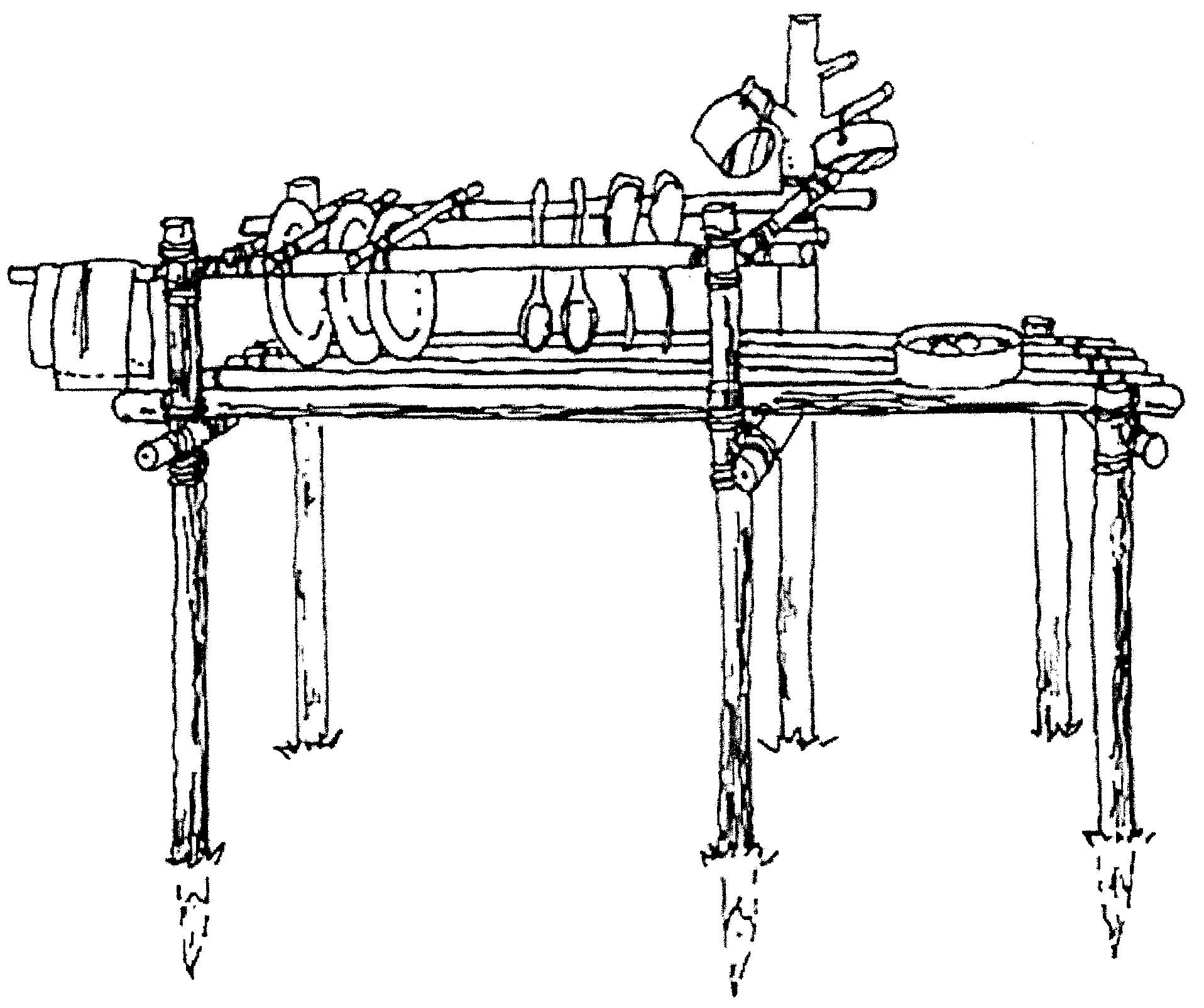
How many kinds of Lashing can you find in this project?.
